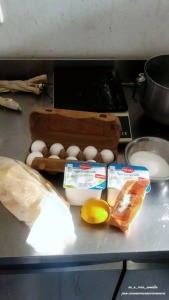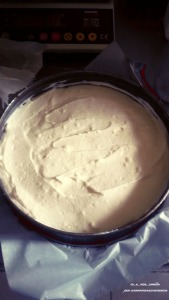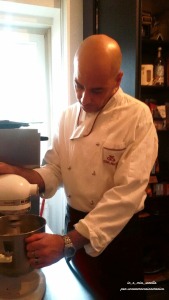“Dei palati uguaglianza non può stare,
perciò non s’ha dei gusti a disputare”
(Proverbio Popolare)
Puntuali come non siamo mai stati, organizzati e seri come non saremo mai più, siamo pronti per la Seconda Puntata della ricetta delle “Nuove idee”. Innanzi tutto, per coloro che non avessero letto la prima, vi invitiamo a cliccare qui . Per tutti gli altri.. aspettate due minuti che i ritardatari leggano.
…..
Ok, i due minuti sono passati. Iniziamo, allora.
E iniziamo col nome della nuova ricetta: la Käsekuchen (Käse, dal tedesco, formaggio). Ah, la “ä” si legge come una “e”.
Come vedete, qui prendono sul serio qualsiasi cosa: volete mettere come suona “Käsekuchen” rispetto a “Torta al formaggio”? Non aggiungo altro.
“Non sottovalutate questo dolce”, sentenzia Christian il pasticcere, “perché anche se non ci si pensa, tutto il mondo mangia Käsekuchen, ma tutto il mondo la prepara in modi diversi”. (“Hai capito!”, sussurro io costernata!)
La ricetta cambia da paese a paese, influenzata dal clima, dalle materie prime, dal gusto popolare, tutti fattori che in qualche modo contribuiscono a rendere il dolce quasi “unico” in ogni nazione.
L’Italia vanta la sua fantastica Pastiera Napoletana , le Crostate alla ricotta e l’intramontabile Cassata Siciliana – nei paesi dal clima moderato o caldo, i dolci sono infatti più “dolci” e meno grassi – gli Stati Uniti d’America si tengono stretta, sventolandola come una bandiera, la loro Cheesecake, la Francia pensa che la sua Tarte au fromage blanc ( a base di pasta sfoglia, non di frolla) abbia un gusto inimitabile e sopraffino (sono francesi, che volete..).
Noi siamo in Baviera, Germania, e qui c’è la Käsekuchen.
A causa del clima più freddo rispetto a quello mediterraneo, ad esempio, questa torta ha un gusto più grasso e meno zuccheroso, ma buonissimo. Viene farcita con un formaggio locale, il Quark, fresco e dal sapore un po’ acido (detta così sembra cattivo, ma non lo è!), e qui è il dolce più consumato, a qualsiasi ora, in ogni stagione e senza un motivo apparente – non per fame, né per colazione, insieme al caffè, insieme alla birra! – solo e soltanto perché è la Käsekuchen.
Ho visto Christian preparare Käsekuchen come se non ci fosse un domani, e clienti assaporarla ad occhi chiusi, felici come “il bambino che si tuffa dentro ad un bignè” del caro Claudio Baglioni.
Quindi ho capito. Se sei tedesco, ti piace la Käsekuchen, è una roba congenita: da bravi reporter/viaggiatori/espatriati, come potevamo non parlarvene?
Infatti lo facciamo. Subito. Imparate con noi la ricetta della Käsekuchen, si sa mai che un giorno invitiate a casa un tedesco, fareste un figurone! (Per i ringraziamenti vi aspettiamo nei commenti..).
Difficoltà: media (eccola là, direi se fossi a Roma..)
Ingredienti: (per una torta)
1 Kg Formaggio Quark
8 Uova
200 gr Zucchero semolato
Scorza di 1 Limone
1 Pizzico di Cannella (facoltativo)
80 gr Uvetta (facoltativo)
Preparazione:
Prendete il panetto di pasta frolla che è rimasta nel vostro frigorifero (se l’avete effettivamente usata per fare i biscotti suggeriti nella prima puntata, avrete già la dose giusta di frolla, se invece non li avete fatti, la ricetta della pasta frolla è in realtà per due torte.. quindi dimezzate le dosi che trovate scritte!).
Su un piano infarinato, impastatelo a mano per ammorbidirlo un po’.
Con l’aiuto di un mattarello create un disco di pasta frolla molto sottile delle dimensioni di una pizza.
Prendete quindi uno stampo a cerniera (di 28 cm di diametro e di 5 cm di altezza), e con l’aiuto del mattarello arrotolate il disco di frolla e adagiatelo nello stampo. Fate aderire bene la pasta allo stampo stesso e realizzate un bordo di circa 2 cm di altezza.
Nella planetaria – o in una ciotola capiente – mettete il Quark e montatelo a velocità media (se avete optato per la ciotola vi servirà un mix ad immersione). Quando il quark sarà cremoso aggiungete la scorza di limone, eventualmente cannella e uvetta, e lo zucchero e continuate a girare. Quando questi ultimi ingredienti si saranno completamente amalgamati tra di loro, unite le uova (sia il bianco che il rosso) al composto, uno alla volta mi raccomando, e aumentate la velocità della planetaria – o del mix – al massimo.
Attendete che anche le uova si uniscano al resto, poi fate montare il tutto fino a che non otterrete una crema liscia e spumosa.
A questo punto versate il composto nello stampo e poi nel forno preriscaldato a 160° se è forno ventilato, a 170° in caso contrario, per 50 minuti circa.
Finita la cottura, lasciate riposare il vostro dolce nel forno spento per ulteriori 10 minuti.
Se avete fatto le cose a dovere, la vostra Käsekuchen avrà raddoppiato la sua altezza: noterete che raffreddandosi, un pochino si sgonfierà.. non andate nel panico, è normale!
Toglietela quindi dal forno e lasciatela raffreddare a temperatura ambiente, tenendola ancora nello stampo.
Dopo circa un’ora, anche se ancora tiepida, con cura estraete la torta dallo stampo adagiandola su un vassoio.
La vostra Käsekuchen è finalmente pronta: si può mangiare tiepida o fredda, e se volete renderla ancora più bella, spolveratela con dello zucchero a velo.
Buon appetito!
La nota patriottica di Christian:
Ogni tanto, quando mi viene un po’ di nostalgia di casa, vado a fare la spesa e nel banco frigo anziché il quark prendo la ricotta.. quel giorno, per tutti i gentili clienti tedeschi, preparo la mia “Käsekuchen all’italiana”.
Potete farlo anche voi, visto che in Italia il quark non è semplice da trovare: la cosa importante è che scegliate un formaggio fresco dalla consistenza morbida (tipo quella della ricotta, appunto. Yogurt, mascarpone, etc. sono ovviamente da scartare).
Quando la preparo all’italiana, qui in Baviera se ne accorgono subito, ma apprezzano e sorridono ugualmente.. del resto, a noi italiani sul cibo non si può rimproverare proprio nulla!!
Buona giornata a tutti!
Sabrina e Christian
“In matters of taste, there can be no disputes“
(Popular proverb)
This time we are timely, professional and organized like never before (and maybe never will). So, here we go with the second episode continuing with our “New ideas”. First of all, for those who missed the first part, you can read it here. For all of you who already did it…just wait two minutes more for latecomers to read.
….
Ok, two minutes are gone. So, let’s start.
And let’s start with our new recipe: Käsekuchen (Käse in German means “cheese”). Ah, in German ä is pronounced like ay in “say”.
“Don’t underestimate this dessert”, says Christian the pastry chef, “because even if you have never thought about it, actually everybody eats Käsekuchen, but all over the world is prepared in different ways. (“Oh really?!” I astonishingly said to myself!)
The recipe may vary depending on the country because other factors have to be taken into account, like climate, raw materials, national cuisine and anything that can make that particular dessert one of a kind in its own country.
In Italy we have the fantastic Pastiera Napoletana, crostate alla ricotta (crostata is Italian for “pie”, TN) and the evergreen cassata siciliana, (small remark: in hot weather countries desserts are “sweeter” but with less fats) – and while the United States is fond of its cheesecake, France thinks that its tarte au fromage blanc (with puff pastry, instead of shortcrust pastry) is absolutely unique (they are French, by the way…)
We live in Bayern, Germany and here they call it Käsekuchen.
Due to a colder climate, unlike the Mediterranean one, here this cake tastes fattier and less sweet, but still tastes great. It is filled with Quark, a typical German cheese with a fresh and lightly acid taste (it seems not so tasty from the way I described it, but it is, indeed!) and here Käsekuchen is the most common dessert. People eat it at any time, any season and they don’t need any obvious reason to do it; not because they are hungry, not because it’s breakfast or coffee time – since they also eat it with a beer – but simply because it’s Käsekuchen.
I watched Christian preparing Käsekuchen as if there was no tomorrow and guests enjoying it with their eyes closed and happy like “a child diving in a cream puff”, as the Italian singer Claudio Baglioni sings.
And then I got it. If you are German and you like Käsekuchen, it means that it is in your DNA. So in quality of diligent reporters/travelers/expats, how could we not talk about this?
So let’s do it. Now. Learn with us how to cook a Käsekuchen. You never know, someday you may invite a German to your house and it would be a nice surprise! (Thank me later in the comments, please…)
Difficulty: medium
Ingredients: (for 1 cake)
1 kg / 35 oz Quark cheese
8 eggs
200g / 7 oz caster sugar
Lemon zest (1 lemon)
A pinch of cinnamon (optional)
80g / 3 oz raisins (optional)
Preparation:
Take the shortcrust dough ball out of the fridge (if you prepared the cookies of our first episode, now you will have the right dose of shortcrust dough; if not, the previous recipe is actually for two cakes…so halve the dose that you find there!).
Knead the dough on a floured surface using your hands, in order to make it softer.
With the help of a rolling pin shaping the shortcrust dough into a very thin disk, as large as a pizza.
Then take a springform pan (28cm diameter and 5cm height) and with the help of a rolling pin, roll the pizza-like disk and place it in the pan. Make sure that the dough is well fixed to the mold and crimp the edges of a length of 2cm (0.78 inches).
Pour the Quark in a planetary mixer or in a big bowl, and whip it at a medium speed (if you use a bowl you will need a hand blender). Once the cheese will be creamy, add lemon zest and sugar and if you want also cinnamon and raisins. Keep stirring. Once all the ingredients will be well mixed, add the eggs (both yolk and white) but add one egg a time and gradually increase the speed of the planetary to the maximum.
Wait for the eggs to combine with the rest, then whip everything together until you have a foamy and smooth cream.
At this point pour the mix in the mold and then place it in a preheated oven at 160 degrees (325 degrees F) if it’s ventilated, or 170 degrees (335 degrees F) if it’s not, for 50 minutes.
Once it is cooked, let the dessert rest for 10 minutes more in the previously turned off oven.
If you followed the instructions, your Käsekuchen should be double in height by now. But you will notice that as soon as it gets colder, it deflates. Don’t worry, it must to be like that!
Take it out of the oven and let it cool down, keeping it in the mold.
After one hour, even if it is still warm, carefully take the cake out of the mold and place it on a tray.
Your Käsekuchen is ready: you can eat it cold or warm, and you can add some powdered sugar on it, to make it even more appetizing.
Christian’s nostalgic remark:
Once in a while, when I feel homesick, I go to the supermarket and I buy ricotta cheese, instead of Quark…and on that day I prepare anItalian Käsekuchen for all my German guests.
You can do it too, since in Italy it is not easy to find Quark. The important thing is to choose a creamy and fresh cheese, like ricotta (I suggest you to avoid yoghurt and mascarpone cheese etc…)
Every time I prepare it in this way, here in Bayern people easily recognize it but still they like it and they keep on smiling…after all, we are Italians and nobody can say something about food!
Have a nice day everybody!
Sabrina & Christian
Traduzione a cura di Daniela Masciotra
Translated by Daniela Masciotra








Io aaaaaaaamooooooo le torte al formaggio 🙂 E niente, mi emoziono quando leggo una ricetta accompagnata da tanta passione, che ci posso fare? La cucina è uno degli atti d’amore più belli e più spontanei, non è una frase buttata lì, pensa che cucinare per qualcuno vuol dire sostentarlo, coccolarlo, donare qualcosa di te per renderlo felice, dal momento in cui scegli cosa cucinare, vai a fare la spesa, organizzi la tua cucina e fai una magia…trasformi qualcosa in altro. Amate e cucinate, cucinate e amate!! 🙂
Grazie Stefania, siamo contenti ti sia arrivata anche la passione, oltre che la ricetta in sé.. hai ragione, la cucina è molto di più che preparare qualcosa da mangiare. Io non sono poi così brava, anche se il cuore ce lo metto.. per il resto, c’è Christian!!!
Tu cucini? Se mai ti andrà di ripetere questa ricetta, facci sapere come ti è venuta.. ne saremmo felici (e pure un po’ orgogliosi!!)
Grazie ancora, un abbraccio
Sabrina e Christian